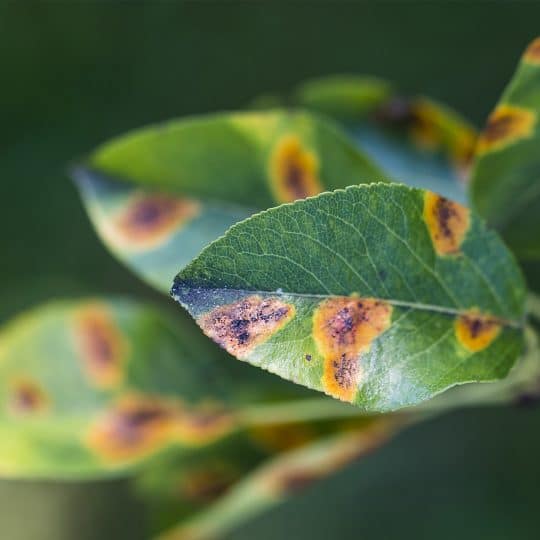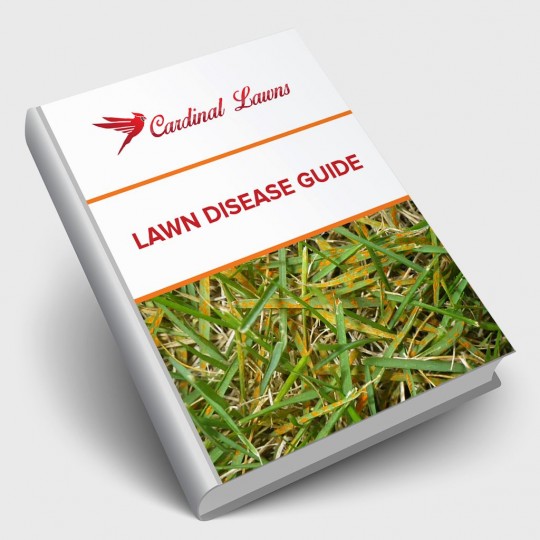Leaf Spot Disease
What Does it Mean for your Trees
Posted
April 19, 2018

Leaf spot can appear on a wide range of trees and shrubs. This disease weakens plants, but are a minor stress on the health of the tree. However, if leaf spot leads to complete leaf loss two to four years in a row, it should be taken more seriously.
The majority of leaf spot diseases are caused by fungi, but a few are brought on by bacteria or other pathogens. Many of these pathogens are species specific and will only infect the same type of trees, but almost all trees and shrubs are susceptible to one or more leaf spot diseases.
Identifying Leaf Spot Disease
Leaf spot come in a wide variety of shapes, sizes, and colors, and are frequently found on the lower and inner branches where humidity is higher and leaves are more shaded. Spots occur randomly on leaves because bacteria is blown or splashed onto the surface. Some leaf spot pathogens cause leaves to drop prematurely, and can also infect buds and young twigs. Here are some other signs of certain types of leaf spot:
- Leaf rusts. Bright yellow, orange, or red powdery spores that are easily rubbed off. Leaf rust fungi can also infect young green stems and fruit on the same tree. Rust spores infections are caused when leaves remain wet for long periods of time. The disease spreads when blown long distances. Reduce rust infections by not planting susceptible plants in close proximity to one another.
- Downy mildews. Caused by water mold, and first noticeable as light green spots on the upper side of the leaf that turn brown over time. Downy, white clumps and spores form on the underside of leaves during humid weather. Young, infected leaves may become distorted. More of an issue in rainy climates, and rarely a problem in hot dry weather.
- Bacterial leaf spots. Start as small, dark brown or black spots with a halo of yellow around it. The center of the leaf spot may dry up and fall out, and some spots grow together to create large, black blotches on leaves. Shoots, buds, and flowers can also become black and blighted by bacterial leaf spot.
Managing Leaf Spot
Follow the following tips to help manage the spread of certain leaf spot disease.
- Rake up and destroy fallen leaves before the first snowfall to remove pathogens that can survive the winter and re-infect the plant the following growing season.
- Don’t overcrowd plants—use size at maturity as a spacing guide when planting.
- Prune trees or shrubs to increase light penetration and improve air circulation throughout the canopy to encourage healthy plant growth.
- Wet conditions promote disease, so avoid or redirect lawn and landscape sprinklers that wet the lower canopy of the tree.
- Water your tree throughout the growing season so that the top six to eight inches of the soil is moist, especially during dry summer periods. Soil should be dry before watering again.
- Don’t fertilize trees and shrubs suffering from leaf spot diseases, unless it is recommended by a soil test to correct a nutrient deficiency.
- Prune infected branches several inches below visible signs of the infection, then burn or bury them to prevent spreading.
- If the tree prematurely loses leaves several years in a row, use fungicide sprays to help treat and prevent fungal disease. Sprays with copper or streptomycin as an active ingredient are effective in preventing bacterial diseases.
- Hire a professional arborist to treat leaf spot diseases in large trees.
If your trees or shrubs are consistently losing leaves to leaf spots, contact Cardinal Lawns to discuss your options.

Download Your FREE Lawn Disease Guide
Even the most manicured landscapes are susceptible to lawn disease. Take some time to learn about identification and removal before one takes over your lawn. This handy guide teaches you how to spot common lawn diseases as well as how to properly treat them.